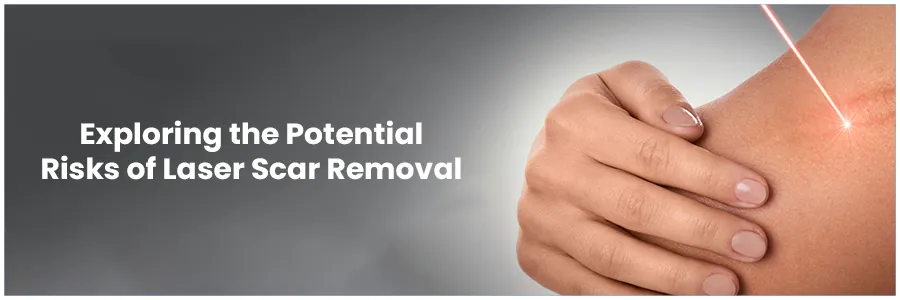Exploring the Potential Risks of Laser Scar Removal

Laser scar removal has gained popularity as a non-invasive and effective method for reducing the appearance of scars resulting from various injuries, surgeries, or skin conditions. This procedure uses laser technology to target and break down scar tissue, stimulating the body's natural healing process. While laser scar removal offers numerous benefits, it's essential to be aware of the potential risks associated with the procedure to make informed decisions about its suitability.
Benefits and Mechanism of Laser Scar Removal:
- Explanation of how laser scar removal works to break down scar tissue and promote collagen production.
- Benefits include reduced scar visibility, improved skin texture, and minimal downtime.
Common Types of Lasers Used for Scar Removal
- An overview of different laser types, such as ablative and non-ablative lasers.
- Explanation of how each type targets scar tissue and stimulates skin regeneration.
Potential Risks and Complications:
- Hyperpigmentation and Hypopigmentation: - Definition of hyperpigmentation (darkening) and hypopigmentation (lightening) of the skin. - Explanation of how laser treatments can disrupt skin pigmentation and lead to uneven skin tone.
- Scarring and Aggravation of Existing Scars: - Discussion of the paradoxical effect, where improper use of lasers can worsen scarring. - Description of scenarios where scar tissue may react negatively to laser treatment.
- Pain, Discomfort, and Swelling: - Explanation of the common post-treatment side effects, such as pain, discomfort, and swelling. - Discussion on managing these side effects and their temporary nature.
- Infection and Delayed Healing: - Explanation of how the skin's barrier can be compromised, leading to infection risks. - Discussion on the importance of proper aftercare and hygiene to prevent complications.
- Skin Sensitivity and Burns: - Description of how lasers can cause burns if misused or if the skin is overly sensitive. - Explanation of the importance of adjusting laser settings based on individual skin types.
- Allergic Reactions and Changes in Skin Texture: - Discussion of potential allergic reactions to laser treatments. - Explanation of how skin texture changes, including roughness or thinning, can occur.
- Unpredictable Results: - Highlighting the fact that laser scar removal results can vary depending on factors such as scar type, skin tone, and individual response.
Precautions and Considerations
- Importance of choosing a qualified and experienced medical professional for the procedure.
- The necessity of a comprehensive skin evaluation before undergoing laser scar removal.
- Detailed discussion on discussing potential risks and benefits with the medical provider before proceeding.
- Overview of skin types and conditions that may not be suitable for laser scar removal.
Aftercare and Minimising Risks
- Guidance on proper post-treatment care to reduce the risk of complications.
- Tips for protecting treated skin from sun exposure and using recommended skincare products.
- The significance of adhering to the medical provider's instructions for optimal healing.
Conclusion :
Laser scar removal can offer significant benefits in improving the appearance of scars, but it's essential to be informed about the potential risks and complications associated with the procedure. By understanding these risks and taking necessary precautions, individuals can make well-informed decisions and maximise the chances of a successful outcome from laser scar removal. Always consult with a qualified medical professional to determine the most suitable treatment plan for individual needs and skin types.
